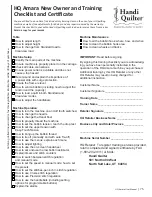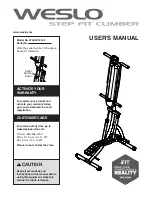
66 |
www.HandiQuilter.com
The needle is not positioned
properly
• Position the needle properly to the needle bar. Inspect the
position of the needle to make sure the needle is at the 6 o’clock
position. When you stand directly in front of the needle (facing the
bobbin case side of the machine), you will see the entire needle
eye directly facing you. This is 6 o’clock position.
• Make sure (a) the needle is installed all the way into the needle
bar to the needle-stop hole, (b) the long groove in the needle is
toward the front (bobbin case side), and (c) the scarf (scooped out
part of the back of the needle) is toward the back of the machine.
• The needle can sometimes be rotated to 5 o’clock (slightly right)
or 7 o’clock (slightly left) to adjust for a more positive thread loop
pickup by the hook point.
The Needle Breaks
Corrective Measure(s)
The needle is bent or not
installed properly
• Replace the needle. Make sure that the needle is pushed into the
needle bar clamp until it can go no further. Visually check that it is
up to the top of the sight hole above the needle bar clamp screw.
If the needle isn’t installed properly, it can cause damage in the
bobbin area and throat plate.
The needle hits the throat plate
• Correctly position the needle, throat plate, or hopping foot.
Replace with a new needle.
Stitches are Puckered
Corrective Measure(s)
The tension is not balanced
• Balance the tension of the needle thread after ensuring the
bobbin tension is adjusted correctly. (For more information about
adjusting tension, see Bobbin and Bobbin Tension and Easy-Touch
Tension™ in the Using Your Machine section of this manual.)
Needle too large for
quilting fabric
• Replace the needle with a size better suited for the fabric.
Poor Stitch Quality
Corrective Measure(s)
The tension is not balanced
• Balance the tension of the needle thread after ensuring the
bobbin tension is adjusted correctly. (For more information about
adjusting tension, see Bobbin and Bobbin Tension and Easy-Touch
Tension™ in the Using Your Machine section of this manual.)
Bobbin case is damaged,
corroded, dirty, etc.
• Since thread slides over the surface of the bobbin case at a high
speed, make sure the case is free of any lint or foreign matter that
could impede thread passage through the machine.
Moving the machine too fast
for needle speed selected
(Manual mode)
• Synchronize machine movement and needle speed to get your
desired stitch length. Elongated stitches are an indication of
moving the machine too fast for the current speed.












































